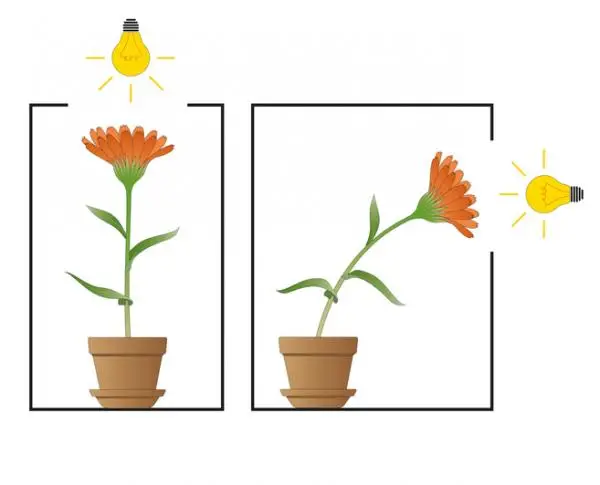All living things are capable of responding to external stimuli. From a simple caress to the changes in temperatures caused by the lack of sunlight. In this case, the plants are no exception and although some perform movements that we are capable of directly appreciating, there are other slow movements but that implies a favorable development for them. These movements resulting from stimuli such as the search for light or water or the need to move away from other agents are called tropisms.
In this article, we will talk to you about this interesting phenomenon so that you know everything you need to know about this botanical topic and also to assess and improve the growth of the plants that are part of your home. If you want to find out what tropism is, its types and examples , keep reading!
What is tropism
The definition of tropism can be summarized as the biological phenomenon that plants carry out as they grow, making a displacement caused by an environmental stimulus.
The tropism can be both positive and negative and is, as we have already mentioned, directly related to the growth of the plant . If this is oriented towards the stimulus it is considered positive tropism and if it tries to move the plant away from it, it is called negative tropism .

Types of tropism
Next, we are going to list the different types of tropism existing in the plant world and then give you some clear examples.
Phototropism
Phototropism is the movement produced by plants when exposed to sunlight. This movement is vital to favor processes as important as photosynthesis.
Geotropism
Geotropism is a movement that implies the orientation of the plant with respect to the Earth’s axis of gravity. In this way, the roots of the plant are oriented towards the ground (positive tropism) and the stem grows in the opposite direction to the ground (negative tropism). This movement is vital to get the plant to germinate and grow.
Hydrotropism
It is the movement resulting from the need to get water for the survival of the plant, vital for its survival and optimal development. The roots of most plants tend to grow towards where they detect water.
Thigmotropism
It is the movement that occurs after the reaction of an encounter with a solid element. The result is usually that the plant either surrounds this obstacle by growing around it or that, in some cases, it encompasses it and forms part of its structure.
Chemotropism
Very similar to hydrotropism, chemotropism is the resulting movement after the search for substances necessary and beneficial for the growth of the plant. These substances are found in the soil, so this process corresponds mainly to the roots of plants.
Aerotropism
Plants also perform a movement called aerotropism depending on the presence or absence of air in the place where they are. Depending on the species it will grow towards the area with the greatest possible ventilation or, on the contrary.
Examples of tropism
After having named the types of tropism that exist, we are going to see some clear examples of each of them so that it is much easier for you to differentiate them and even recognize them in the plants that surround you. Here are some examples of tropism in plants :
- Sunflowers are one of the best examples of positive phototropism , as they always grow facing the sun. Although some experts consider that perhaps such a clear growth movement should not be considered tropism.
- Some aquatic plants grow in the opposite direction to sunlight. This type of negative phototropism is vital for them since a higher solar incidence would imply that, in the long run, it would imply the evaporation of water and therefore the loss of the environment it needs to live.
- A clear example of positive hydrotropism is that performed by ficus roots in search of the water sources they need. In big cities they get to lift the pavement in order to reach the desired place.
- In the case of an example of thigmotropism and that you have surely observed on several occasions, it is the one performed by climbing plants , such as ivy. Some plants that carry out this type of tropism can be harmful to other species since, by wrapping them, they take away the light and CO2.

Difference between tropism and nastia
The first thing you should know is that, although both tropism and nastia refer to movements made by plants, there are two clear differences between these mechanisms. These are the main differences between tropism and nastia :
- The main one is that tropism refers to a permanent movement, while nastia is a specific movement that happens over a period of time. In some cases the nastias can last for hours or just seconds.
- The other big difference is that the nastia is a reversible movement, while the tropism implies a definitive and irreversible movement.
So that you can understand it better, we remind you of the movement that mimosas make when closing their leaves to avoid damage in the case of nastias, that is, it is a reversible movement, and the growth of sunflowers towards sunlight in the case of tropism, which is a constant and non-reversible movement.
Difference between tropism and taxi
In the case of the difference between tropisimo and taxi, you just need to know that taxi is a movement that usually involves a movement in response to a stimulus, such as light, and that all living beings can perform except plants. .
In the same way, the taxsimo that the animals carry out can also be positive or negative, that is, they can move towards the focus of the stimulus or away from it. Generally, although there are several types, these movements are related to changes in temperature.


2 thoughts on “Tropism: what it is, types, and examples”